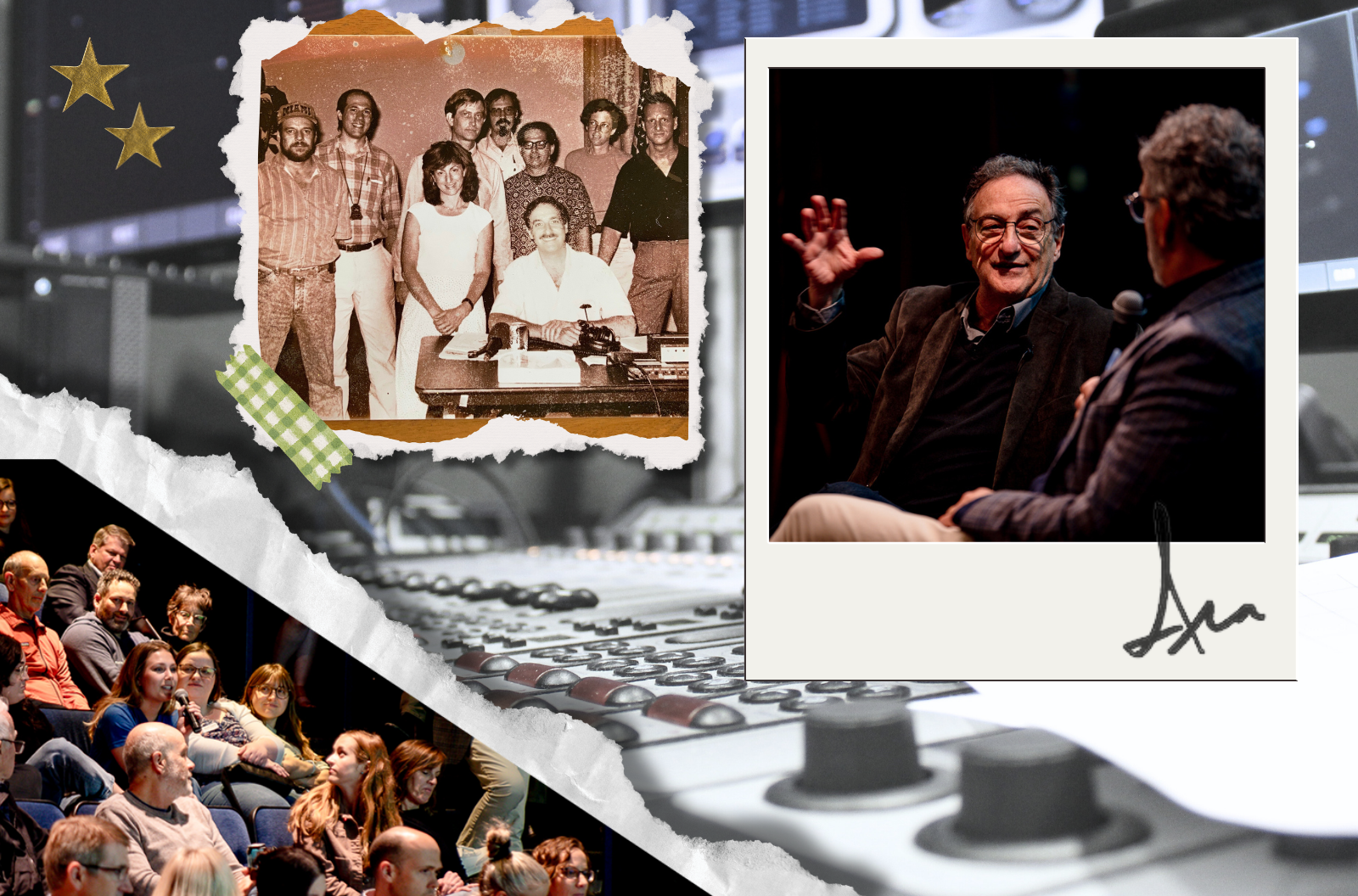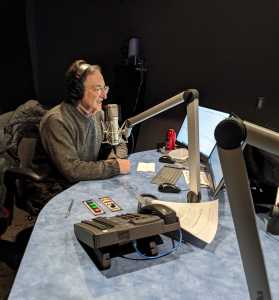What I Learned Setting Up The Science Friday Archive
I had two months to make sense of 33 years of programs–and set Science Friday up to document its future.

Collage by Emma Gometz
Upon my arrival at the Science Friday office in New York, I was greeted by a black-and-white cardboard cutout of host Ira Flatow adorned with a kitschy 90’s necktie. The fake Ira was propped up next to a very real shelf filled haphazardly with cardboard boxes marked with various dates and media formats. This was the Science Friday Archive—or what would become it—and it was my job to make sense of it.
When one arrives as an archivist or archives assistant at a new institution, most of the job consists of figuring out what exactly the institution has and where it’s located. Science Friday was no different, although I was pleased to be welcomed by a kind and empathetic team who fielded my myriad of questions with a charming mix of humor and curiosity. There’s a certain irony to being brought in as a subject matter expert to a small team of people who are scientifically minded subject matter experts in their own right. I knew very little about the world of public radio broadcasting, and they knew very little about what goes into building an archive. True to the spirit of Science Friday, we’ve learned a good deal from each other.
I was given spreadsheets documenting aspects of each episode going back to the show’s inception. I quickly learned that Science Friday as a program was started in 1991. While SciFri has always been an independent production, it aired originally as part of NPR’s “Talk of the Nation” program every week on—go figure—Fridays. When “Talk of the Nation” was canceled in 2013, Science Friday continued to be distributed by NPR as a separate show. It then went on to be distributed by PRI in 2014 and eventually WNYC starting in 2018.
While most institutions would love to have an archivist to keep their records, the reality is that beyond universities, libraries, and museums, few have the resources for it. So what often happens is that a nonprofit chugs along for a few decades, keeping records in whatever fashion it sees fit, and eventually hires a temporary archivist when they realize their collection has grown in scope and they don’t quite know what to make of it all. This is where I come in, I suppose you could think of me as a bit of a housekeeper.
“With over 30 years of interviews, there are a ton of gems in there,” Flatow said of the show’s collection. “But being able to quickly lay your hands on them in a sea of tape is the difficult part. This project will make it easier to find those great moments of science history we love talking about.”

I was with Science Friday for just over two months, and my main objectives were to organize both physical and digital materials for long-term preservation and create a database so that SciFri could keep its work organized moving forward. A key part of that was adopting the metadata standard used by public media, called PBCore. It was launched in 2005 and has since grown into a robust set of standards and tools specifically for archiving and cataloging audiovisual material and their attendant metadata. It felt good to be working from a standard created by and for public broadcasting, and for a moment really made me feel like a part of the broader public broadcasting community.
While this project sadly didn’t require much actual listening to Science Friday, one does of course notice some oddities in any archive. The first thing that stuck out to me was that Science Friday didn’t broadcast during emergencies or times of significant national stress, when NPR instead opted for news coverage. The biggest example of missing shows was in the weeks after 9/11.
I couldn’t resist listening to some of these historically significant episodes and appreciated that when SciFri was a part of “Talk of the Nation” you got the political and historical context of that day’s science news before the program began. I also couldn’t help but listen to a personally significant SciFri episode: the one that aired on September 18, 1992, the day I was born. I was more than a bit surprised to find that the entire first hour of this episode consisted of a measured debate on climate change, then referred to as global warming, between scientists and callers to the show. It was surreal to hear the tenor of the conversation on the issue that would define my generation taking place on the day I was born. I decided to contrast this with the most recent episode of SciFri where, wouldn’t you know it, the news roundup was about measuring wet bulb temperatures and the featured segment was a 20-year retrospective on municipal climate policy. This is one of my favorite parts of archive work: You can’t help but see the past in conversation with the present.
I’m pleased to report that the house at Science Friday is in much better order than when I arrived, with no disrespect to the hardworking people who managed the records as best they could for 30+ years. I got rid of the old cardboard boxes and stored the CDs containing every episode of Science Friday in proper archival quality boxes that will last well into the future, and reorganized them accordingly. Those materials will join the American Archive of Public Broadcasting project, a collaboration between the Library of Congress and GBH, and become accessible to anyone. I’ve also built a digital database to keep track of all the juicy metadata that is the lifeblood of digital archiving projects to ensure that for years to come, people will know who and what went into each episode of Science Friday.
While I’ll be sad to leave Science Friday after such a brief stint, I’m very proud to have helped set it up for future success and ensure that people will always be able to access the dulcet enthusiasm of Ira Flatow and company. As in all things public broadcasting, this was possible not just through the labor of myself, Ira, or the team, but also the contributions of people like you. From the listeners who called in to the science fans who have donated over the years, you all live on in this archive as well, and I think that’s pretty cool. Here’s to Science Friday, and you, continuing to make history.
Support for Science Friday’s archive project comes from the Heising-Simons Foundation.
Keaton Slansky is a freelance writer and archives assistant based in Brooklyn, New York. They earned a master’s in politics from The New School for Social Research in 2023 and fell into archive work after helping to catalog the personal collection of Michelle Materre, a prolific distributor of early African American cinema.